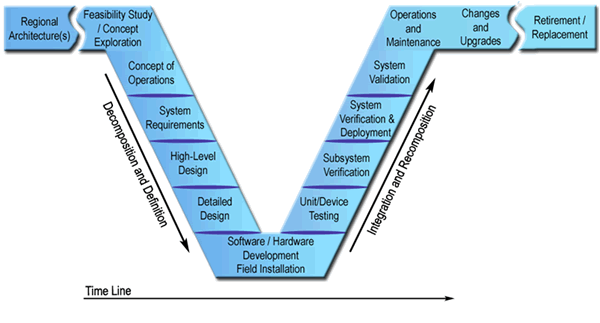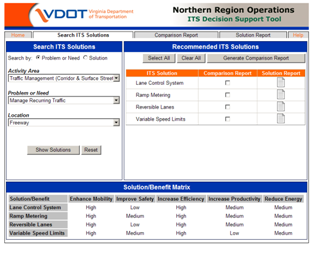Project Concept Development | Project Initiation | Project Implementation
Initiating, Developing, and Deploying an ITS Project
Within the Program Development and Program Delivery phases of the Planning and Program Delivery Process additional activities are being executed. The activities are oriented on the Systems Engineering process which guides ITS project development and consist of Project Concept Development, Project Initiation, and Project Implementation.
Project (Concept) Development
Project development is accomplished within the Program Development step of the NRO PPD Process. This section provides details for activities 2 – 6. Through Rule 940, USDOT requires the use of the systems engineering process to develop ITS projects. The figure below illustrates the systems engineering V diagram that USDOT encourages use of in pursuit of Rule 940 compliance. The following presents the project development process and NRO’s application of the Systems Engineering process. To initiate the process, a need or problem must be defined which requires a solution to resolve it. The definition of some problems/needs was done in the PPD steps in the Planning Process. The problems/needs initiate the systems engineering V diagram activities from the far left side.

Problems/Needs Addressed - Ultimately, a project is addressing a particular problem or need. The problem or need must be clearly defined and documented. In some cases it may be difficult to single out the problem being addressed or what particular project will address the issue. To assist project developers with problem definition, VDOT NRO has developed an ITS Decision Support Tool (ITS-DST) to aid in defining the issue as well as promoting solutions to be considered. The ITS-DST may not be needed when the project manager has a clear vision for the problem and its solution.
 The ITS Decision Support Tool is a web-based application developed to assist transportation professionals in identifying ITS Solutions. Beginning with a problem, users can answer a series of questions that will lead them to a list of potential ITS solutions that may be able to solve the problem. Once a solution is identified, the user is provided with a detailed ITS Solution report providing:
The ITS Decision Support Tool is a web-based application developed to assist transportation professionals in identifying ITS Solutions. Beginning with a problem, users can answer a series of questions that will lead them to a list of potential ITS solutions that may be able to solve the problem. Once a solution is identified, the user is provided with a detailed ITS Solution report providing:
- A description of the ITS Solution;
- Equipment and supporting infrastructure to deploy the ITS Solution;
- Traceability to the National ITS Architecture;
- Benefits of the ITS Solution; and
- Cost information.
The definition of the problem that needs to be solved initiates the project development process. The alternative solutions identified by the project developer or produced by the ITS-DST, will be analyzed by the project developer and the best alternative selected. Outputs of the ITS-DST can be used to populate the initial project proposal template. This is done during the feasibility study or concept exploration step early in the systems engineering process. When selecting the alternative, the Northern Virginia ITS Architecture should be used to determine the solution with the best integration opportunities. You might ask why the regional architecture is the first step in the systems engineering V diagram but we just indicated that feasibility studies are first. If you notice the regional architecture step is not directly connected to the V diagram. The architecture has already been developed and the diagram shows that it is a ready reference for the systems engineering process. It is most applicable to the systems engineering activities on the left hand side of the V diagram. The architecture application will be discussed in the following steps.
Project Proposal – Following the alternatives analysis and the selection of a proposed solution, a project proposal must be developed. A Project Proposal Template is available on the Documents and Files page. The proposal includes a description, identification of the problem to be addressed by the project, mapping of the project to the Northern Virginia ITS Architecture, the NRO Strategic Plan, and the NRO Master Plans which can be found on the Documents and Files page. In addition, the Northern Virginia ITS Architecture Turbo Architecture database can be downloaded from the same page and its content examined for applicable elements for the project. The database can be accessed using the Turbo Architecture software from USDOT. The user should review the stakeholders, inventory, services, information flows and standards associated with the project components. Attention should be given to the interfaces with other ITS systems in the architecture to maximize the integration opportunities of the project. These mappings are important to the overall ITS program at NRO to maintain consistency and track progress against the various plans and guides. The proposal includes an implementation strategy defining the tasks, timeline, and estimated cost for the project. The roles and responsibilities of the primary stakeholders and the interdependencies of the project with other projects or existing systems is key to involving the appropriate stakeholders and those operating related systems as the project development is initiated. A plan for evaluation of the project is required as well to properly validate the project performance and deployment objectives.
The project proposal provides information to NRO planning staff to better understand the scope and components of the project. Proposed projects form the basis for the development of the NRO Work Plan for the upcoming fiscal year. The use of the Northern Virginia ITS Architecture as a reference is very important in this step in that it provides insight into the scope of the project and the integration opportunities that should be considered. With these high-level pieces of information, it is time to get into the project details.









